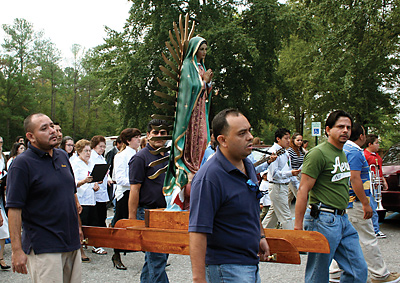
 COLUMBIA—It has been nearly 500 years since Our Lady of Guadalupe first appeared to St. Juan Diego, but time has not diminished her power or importance.
COLUMBIA—It has been nearly 500 years since Our Lady of Guadalupe first appeared to St. Juan Diego, but time has not diminished her power or importance.
Father Filemon Juya, vicar for Hispanic ministry, called Mary the key of unity, saying she is not white, black or Hispanic, but a mixture of all races.
“She is the mother of all humankind; all those who accept her,” Father Juya said.
He is the administrator of St. John of the Cross Church in Batesburg-Leesville, which has a close relationship with St. John Neumann in Columbia. He is in a perfect position to see how the celebration of Our Lady of Guadalupe brings different cultures together and creates “one wonderful fraternity” of people.
Both churches will participate in the Masses and festivities, which usually draw about 1,000 people, he said.
They are among the countless number of celebrations that will be held not only in the Diocese of Charleston, but across all of the Americas.
“I think Our Lady has a lot of meaning for us today,” the vicar said. “It has been a very hard year, and in these difficult moments our faith makes us feel confident that we aren’t abandoned. We have our mother, who is looking out for us.”
Dee Rodriquez, the Hispanic ministry coordinator at St. Gregory the Great Church in Bluffton, said the feast has grown tremendously since the days that only Mexico celebrated.
Over the course of five centuries, 25 popes have honored Our Lady of Guadalupe and expanded her role. She became patron of Latin America in 1910, “Queen of Mexico and Empress of the Americas” in 1945, and “Patroness of the Americas” in 1946.
Then, Pope John Paul II, who canonized St. Juan Diego, gave the liturgical celebration the rank of solemnity when he named Our Lady of Guadalupe patron of the Americas in 1999.
“Now all our brothers and sisters are invited to participate,” Rodriguez said.
At St. Gregory, both Anglo and Hispanic parishioners help cook traditional foods for the feast day, which begins at 5 a.m. with mananitas—a birthday serenade—from the choir.
In some places, Father Juya said, festivities begin with a Vigil Mass and cultural celebration that last throughout the night.
Liliana Contreras, a parishioner at St. John Neumann, said her family always rises at 4 a.m. to attend church, where they greet Mary with song.
In an e-mail to The Miscellany, Contreras wrote that when she was young, she enjoyed the traditions of the feast day—presenting Mary with roses, and the procession and cultural dances—but she did not understand the importance.
As she grew older, she began to appreciate the impact Our Lady of Guadalupe has had on the world.
“She is a role model to me and is the one I pray to. She is the person that gives me strength and courage to go forth with each day. She is the one that gives me the inspiration that women can also be important in this society,” Contreras said.
